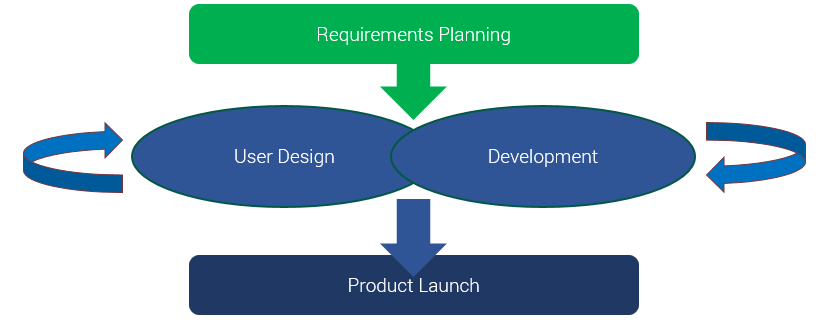- The Definition of RAD
- The 5 Essential Stages of a RAD Model
- Stage 1: Business Modeling
- Stage 2: Data Modeling
- Stage 3: Process Modeling
- Stage 4: Application Generation
- Stage 5: Testing and Turnover
- The Difference between a RAD Model and the Traditional SDLC
- How to Apply the RAD Model
- Knowing When to Use a RAD Model
Rapid Application Development or RAD model is one of the approaches for writing software (you can also read more about Agile development.) There is less long-term planning involved in the process, and more focus is paid to the adaptability of the development workflow.
The RAD model takes information gathered during workshops and other focus groups created to identify what customers want from the product. The initial product is also tested, which helps in the creation of the final product and continued use of the parts of the product that have been proven to be effective.
The Definition of RAD
To fully understand the benefits of RAD, it is essential to know what the meaning of RAD or Rapid Application Development is.
RAD is a type of software development that does not dedicate a lot of time or resources on planning and instead uses a method of prototyping to introduce the product.
A prototype is a version of the product that mimics what that actual product will look like, and it can complete the same functions, which allows for a faster output of the created element.
At the APP Solutions app development coompany, we distinguish several types of prototypes:
- Wireframe prototype – this is a basic drawn picture of the what types of screens will be present in the basic version of the product (or the ones that need to be added in case the product is already past the MVP or Version 1.0 stage.)
- Designed prototype – wireframes that have been made pretty with User Interface (UI) design. Project’s color schemes are already implemented.
- Clickable (functional) prototype – this type of prototype already begins to have rudimentary User Experience (UX) design so that you can see where each of the buttons lead. Sometimes clickable prototypes are entirely designed in terms of UI; sometimes it’s just to show the functionality and the final designs are approved later.
Without an abundance of preplanning in the development stage, the prototype can easily be altered to make changes throughout the testing stages quickly. The team of experts involved in the testing of the app prototype (including the developers, customer service representatives, and IT professionals) works together in a forward motion to get the best version of the prototype possible.
With RAD model of outsource app development, the client can see the demo of the final product much faster. During the creation of a prototype for any product, to save time and money, it is essential to create one that can be reused for fast changes.
SHOULD YOU HIRE APP DEVELOPERS NEAR ME OR OUTSOURCE OVERSEAS?

The 5 Essential Stages of a RAD Model
There are several stages to go through when developing a RAD model including analysis, designing, building, and the final testing phase. These steps can be divided to make them more easily understandable and achievable. The following describes the process included in all RAD models:
Stage 1: Business Modeling
Business modeling step in the RAD model takes information from the company gathered through many business-related sources. This info is then combined into a useful description of how the data can be used when it is processed, and what is making this specific information successful for the industry.
Stage 2: Data Modeling
During the Data Modeling stage, all the information gathered during the Business Modeling phase is analyzed. Through the analysis, the information is grouped into different groups that can be useful to the company. The quality of each data group is carefully examined and given an accurate description. A relationship between these groups and their usefulness as defined in the Business Modeling step is also established during this phase of the RAD model.
WHY CUSTOM APP DEVELOPMENT PROVES TO BE A PERFECT CHOICE

Stage 3: Process Modeling
The Process Modeling phase is the step in the RAD model procedure where all the groups of information gathered during the Data Modeling step are converted into the required usable information. During the Process Modeling stage, changes and optimizations can be done, and the sets of data can be further defined. Any descriptions for adding, removing, or changing the data objects are also created during this phase.
Stage 4: Application Generation
The Application Generation step is when all the information gathered is coded, and the system that is going to be used to create the prototype is built. The data models created are turned into actual prototypes that can be tested in the next step.
Stage 5: Testing and Turnover
The Testing and Turnover stage allows for reduced time in the overall testing of the prototypes created. Every model is tested separately to identify and adapt the components quickly to create the most effective product. Since most of the elements have already been examined previously, there should not be any major problems with your prototype.
4 STEPS TO OUTSOURCE IPHONE APP DEVELOPMENT
Download Free E-book with DevOps Checklist
Download NowThe Difference between a RAD Model and the Traditional SDLC
When completing a traditional style of the Systems Development Life Cycle (SDLC), there is a lot of planning and analysis done before the actual coding process starts.
Such waterfall model can potentially cause challenges for the customer because they are putting their time and resources into a project that is not going to have a substantial MVP for quite some time. The altering of the software after the development can be lengthy, and in some cases impossible to complete after the product reaches a certain point in development.
The RAD model is much more effective because it gives the customer a working model much sooner. The customer can quickly review the prototype, talk to investors in the meantime, showing them what the product would look like, and make changes much more easily.
Granted, the speed isn’t always the best choice to go with – especially when your product is at the later stages of its development, and features get more complicated. For the beginning phases, it can be a good start.
WHAT YOU NEED TO KNOW ABOUT FIVE-STAR APP DEVELOPMENT
The Difference between RAD Model and Agile Model
| RAD Model | Agile Model |
|---|---|
| RAD is used on designing prototypes, and then developers re-engineer the prototypes into production-quality code | Prototypes are used only for design or necessary business analysis during the discovery phase |
| Developers focus on creating the feature (no matter how bad it is at first) and then improve it | The team breaks down the solution into features |
| RAD teams are managed by the project manager (PM)* | Team members are self-managing* |
| The Agile standards described aren’t adhered to in RAD | Developers find and fix the bugs in the code as quickly as possible, and the team has the confidence to change the code without breaking the product. |
| Developers work as individuals (often results in unmaintainable and poorly designed code) | Agile teams focus on communication and developing the product as a team |
* PM – traditional Agile indeed does call for the team members to be self-managing, but at the APP Solutions we still prefer to have a Project Manager for each of the projects and clients because it streamlines the communication processes and makes sure there are fewer misunderstandings.
Read also: Android vs iOS Development

How to Apply the RAD Model
As long as the product being worked on can be easily divided into separate units, the RAD model can be implemented. If the division is not possible, the RAD model may not work.
These are a few of the situations where a RAD model may be successful:
- When the system can be modularized and then distributed in a divided form;
- When there are many designers available for the modeling
- When there is money in the budget for using automated code generating tools;
- When there is an expert available to decide which model should be used (RAD or SDLC);
- When a prototype is expected by the customer within two to three months;
- When changes to the product are planned throughout the development process.
HOSPITAL APPLICATION DEVELOPMENT – EVERYTHING YOU NEED TO KNOW
When to Use the Rapid Application Development (RAD) Model for Your Software Project
The rapid application development model implies fast prototyping of core functionalities, essential design features, and user experience, thereby introducing an iterative, adaptive software development and refining the product based on relevant user feedback. However, it might not be suitable for every company. Here are the common situations when the RAD model is the most beneficial:
- Time-sensitive projects. Startups with tight deadlines are best suited for the RAD model as they need to roll out their ideas quickly.
- Constantly evolving projects. Rapid prototyping benefits companies that must keep up with market changes and accommodate their evolving needs.
- Highly targeted products. Companies that create products for a specific market group and must meet rigorous requirements capitalize on the iterative approach the most.
- Customer-facing products. Iterative development, which provides relevant insights and timely enhancement ideas, greatly advantages products centered around user experience and customer communication.
- Products with the need for quick feature prototyping and testing. Companies that must create, introduce, and validate new product features strongly rely on fast development models and their ability to surface issues and areas of improvement.
